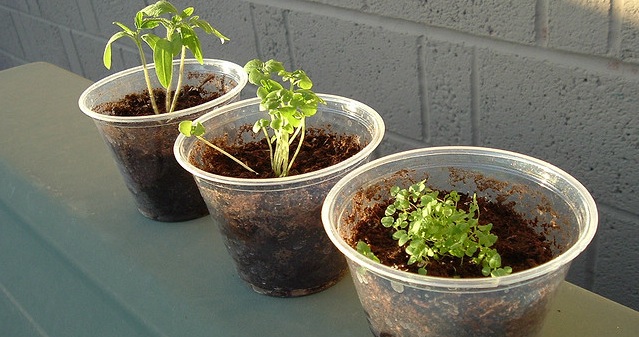Podcast: Play in new window | Download
Several weeks ago on our weekly Gralien Podcast, we mentioned that there was a plant we had hanging around Gralien International that simply had not been doing well. Thus, right in the middle of the broadcast, I proposed an experiment: remembering The Magic of Findhorn, a book I had come across years ago describing the growth of abnormally healthy vegetables in soil lacking in mineral richness, I suggested that we try something novel, and I began talking to the ailing plant.
Prior to this experiment, my attempts at reviving the plant using fertilizer, sunlight, and water had failed miserably. Though there was a very small amount of new growth on the ailing stems, leaves had previously been dropping off like flies from a bug-light. This plant (it’s actually a pair of cordyline plants together in a single pot, which are native to Australia and New Zealand) now has shown remarkable improvement with no fertilizer administered within the last several weeks; only daily water and sunlight, with the addition of my going and “visiting” with the pair for a while whenever I can.
I’m sure this sounds very silly to many of you… I must admit, I haven’t spent that much time talking to plants in the past myself. However, once you take a look at the “before” and “after” photos below, maybe you’ll consider whether the experiment had any beneficial effects… you be the judge!
_____________________________________________________
Gralien Report AUDIO Classics:
Gralien Report Podcast for July 4th, 2011
_____________________________________________________
Below is our “before” image, taken the day we proposed the experiment (approximately one month ago):
And here is the same pair of cordylines one month later, after having received a little verbal TLC from the Gralien gang:
Obviously, there may be a variety of factors that contributed to the plant’s apparent recovery. However, could there be any link between plants receiving a little attention from other species in beneficial, even loving ways? Maybe there is more to some people being described as having a “green thumb” after all, especially when that person is showing genuine care for the plants they are overseeing.
That said, of course, if you aren’t already listening to our weekly show, you can play past episodes using your favorite media player by visiting our archives, or simply by subscribing with iTunes.
“Plant Buddies” image courtesy of Tim Patterson via Flickr.






Question: what has been the level of rain precipitation since the experiment began? More rain, less, or somewhat the same?
I ask because I’m paying attention to the grass in the background, and there seems to be a very slight difference between the ‘before’ and ‘after’ shots.
Or maybe I’m wrong and you actually kept the plant inside the studio during the experiment? I’m a bit confused.
Hey RPJ,
Good observation! I’m noticing that some of the same plant growth can be seen in the background of both images (weeds as well as mere grass), and the primary difference between the two, from what I can tell, is that the length of the grass in the second image is different (it’s a bit longer here than in previous images). You can also tell in the “after” photo that the sky is a bit more overcast and there is less hard light (whereas direct sunlight can be seen in the “before” photo). This may contribute to color differentials, in addition to a few minor differences (I see patches of clover that weren’t present beforehand that appear in the “after” image also, but again, this seems to have more to do with the growth stage of the grass at the time relative to being mowed at the time the photo was taken.
To answer your primary question about rainfall, there has not been an excess of rain in the last month, though I wouldn’t say there has been a drought either. Moderate rainfall in general, and I was careful not to administer any extra water on days coinciding with rainfall. Also, the plant had been placed outdoors approximately two months prior to the beginning of the “experiment,” and this is where it has remained since that time.
It should be noted, of course, that keeping the plant outdoors probably isn’t the most controlled circumstance we could administer in a REAL scientific study, which this certainly was not. If this were done seriously, I’d like to try using more controlled sets of criteria in the future (which would make the present experiment more like previous studies involving people’s actions around plants, and their apparent responses). But for now, I thought listeners might enjoy seeing that this denizen of the “Gralien Greenhouse” is at least doing better!
Hi,
The most common cause of ill health/death in house plants is overwatering. If you are watering every day, I’d suggest cutting back to once every 3 days. Of course, continuing to develop a relationship with your plant can only help it to thrive. Best of luck!
In my eighth grade science experiment, I did a study on the effects of different genres of music on plants. It was very similar to the segment on an episode of “MythBusters”, only about 15 years prior. Out of, I believe, five different types of music, I do remember there being very subtle differences in the growth of the plant exposed to metal and the plant exposed to classical, with the latter having a little more growth.
Interesting to me, but apparently not to my teacher since I received a terrible grade. This was just before the internet and I found next to nothing in terms of this kind of study being done before.
I probably should have stuck to the baking soda volcano.
@wccharlotte,
True visionaries and iconoclasts are never appreciated in their lifetimes. Kudos to you for taking the road less traveled! 🙂